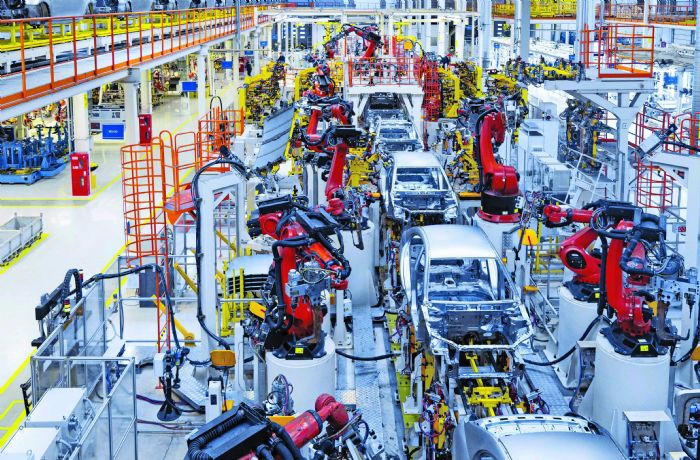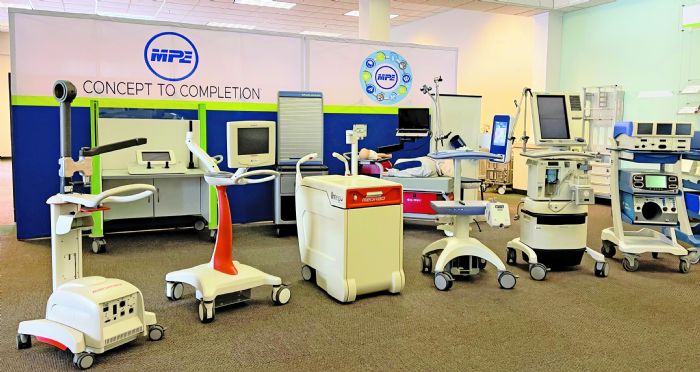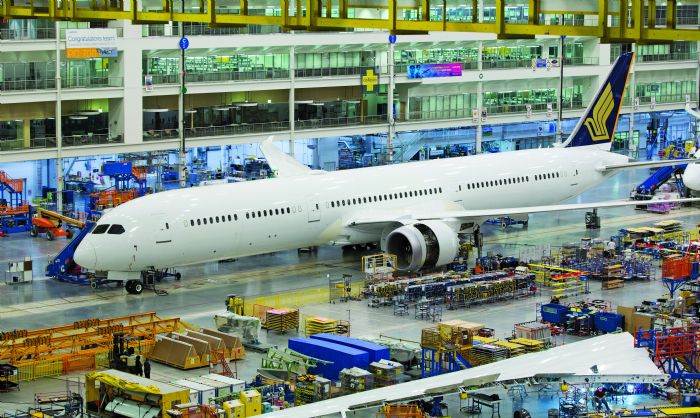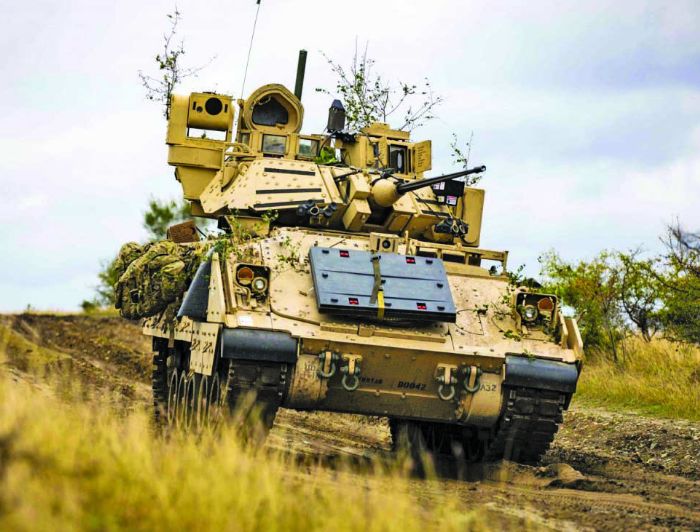Dealing with a scarcity of materials seems like the taller hurdle, and here, “just-in-time inventory is being eclipsed by just-in-case stockpiling as companies buy up raw materials and key components to safeguard production schedules,” Devereux says. “Manufacturers will need to invest more time in sourcing and stocking the right materials to mitigate delays in production.”
One caveat: suppliers, including those providing steel and aluminum, have begun to base customer allocations on their historical purchases. Steve Ford, executive vice president of Lapham-Hickey Steel, noted as much during a late-October 2021 Wipfli panel discussion on supply-chain issues. Suppliers have put measures in place to ensure that their customers don’t purchase more than they need. In addition, purchase orders now are requiring a significantly greater percentage of the included items be designated as non-cancelable and non-returnable.
We also see an ongoing push to automate within metal forming and fabricating companies, just one aspect of an Industry 4.0 transformation that appears, while in its early stages among many metal formers, to be on the edge of an explosion. Devereux concurs, writing: “Digital transformation is poised to grow exponentially as manufacturers retool operations to maintain their competitive advantage. Industry 4.0 capabilities, data management, robotics, machine learning and other aspects of digital transformation will soon be table stakes just to compete for customers and talent. Companies that haven’t developed a digital transformation strategy should start planning now, before their hands are forced and decisions are rushed.”
With that, here we break down the outlook for a handful of key sectors for metal formers and fabricators.
Automotive
 Chip shortages, worker shortages, unpredictable OEM production schedules and rising prices combined with limited supply of commodities have created a perfect storm plaguing the automotive supply chain. Overall, “with just one month remaining,” notes a December 2 report from LMC Automotive, “light-vehicle sales in 2021 appear locked in at 15.0 million units. The month of December is expected to be more of the same, in terms of a selling rate—13.1 million units—the average that the market has been stuck at since June.
Chip shortages, worker shortages, unpredictable OEM production schedules and rising prices combined with limited supply of commodities have created a perfect storm plaguing the automotive supply chain. Overall, “with just one month remaining,” notes a December 2 report from LMC Automotive, “light-vehicle sales in 2021 appear locked in at 15.0 million units. The month of December is expected to be more of the same, in terms of a selling rate—13.1 million units—the average that the market has been stuck at since June.
“The pace of plant shutdowns in North America has slowed from previous months,” the report continues, “and we have reduced the expected production loss in Q4, due to chip shortages and other disruptions, by 100,000. However, vehicle manufacturers are choosing to slow the daily build rate instead of shutting down the entire plant, reducing the visibility of output downtime. With the slight improvement, the 2021 production forecast remains at 12.9 million units, 6000 units lower than 2020. With some additional stability in production, the outlook for U.S. auto sales has improved slightly for 2022—from 15.7 million units to 15.9 million units, an increase of 6 percent over 2021.”
Jeff Schuster, president, Americas operations and global vehicle forecasts at LMC, adds: “A slight improvement in production is welcome news for the industry, though we continue to expect 2021 to have lost 2.4 million units due to the semiconductor shortage. 2022 most certainly will be challenging but if the consumer remains optimistic and demand continues, the recovery is expected to remain intact. Other risks remain elevated, including concerns with the Omicron variant and lingering inflation, keeping the current environment very dynamic.”
On the tooling front, “the next decade is being forecast as generally favorable for suppliers of automotive tooling,” shared Laurie Harbour, president and CEO of Harbour Results Inc. (HRI), during her 2021 Automotive Tooling Outlook report.
“The performance of manufacturing overall is really quite good,” Harbour said. “Durable goods demand is very strong, driving not only new volume but new programs, so lots of new models.”
We’ll have much more to say on the automotive industry in our February 2022 special issue focused exclusively on this most important market to metal formers.
Medical
 The global medical-device outsourcing market is expected to reach $227.1 billion by 2028 and register a CAGR of 11.2 percent during that time, fueled by rising demand for advanced medical products. That according to a 2021 Grand View Research report. Yet another report, from Technavio, reveals slightly less optimism, predicting the medical-device manufacturing outsourcing market to record a CAGR of 7.81 percent through 2025. It attributes the growth to a focus by OEMs on reducing manufacturing costs amid increased complexities in product design and development.
The global medical-device outsourcing market is expected to reach $227.1 billion by 2028 and register a CAGR of 11.2 percent during that time, fueled by rising demand for advanced medical products. That according to a 2021 Grand View Research report. Yet another report, from Technavio, reveals slightly less optimism, predicting the medical-device manufacturing outsourcing market to record a CAGR of 7.81 percent through 2025. It attributes the growth to a focus by OEMs on reducing manufacturing costs amid increased complexities in product design and development.
(Editor’s note: Last year in this space, we wrote: “The global medical-device outsourcing market was expected to grow at a compound annual growth rate of 10.4 percent from 2020 to 2027.”)
Without question, the ongoing pandemic has directed a spotlight onto the medical-device industry, with demand skyrocketing for PPE, diagnostic tests, ventilators and other critical supplies. Suppliers are busy ramping up manufacturing capacity and capabilities, with many expanding outside of their normal customer boundaries, while OEMs have focused on developing more versatile, diverse supply chains. Other industry trends include development of open-source equipment-design processes, and establishment of partnerships with companies not typically involved in the medical-equipment sector.
Over the past few years, medical devices have become more complex both in design and materials used. As a result, many manufacturers have begun searching for ways to reduce material costs and quicken the manufacturing process.
Want to join, or remain, in the med-tech supply chain? Focus on developing these core competencies:
- Hone your ability to quickly uncover inefficient manufacturing processes and improve them, identifying and eliminating those persistent, recurring production hiccups.
- Structure your management team and the production floor to successfully take on new business.
- Maintain industry-leading communication and responsiveness with customers.
- Track and automate Identify those quality metrics that matter most to your customers and track them regularly, responding to any metrics that require attention.
Finally, new regulations loom. According to a recent issue of Medical Products Outsourcing magazine:
“The medical-device manufacturing industry—like most others—is recovering from one of the most challenging years in recent memory. Manufacturers across the sector had to manage disruptions to demand, an unstable supply chain, and new workplace safety practices.
“On May 21, 2021, the new EU Medical Device Regulation (MDR) went into effect,” the article continues. “The MDR, the successor to the 1994 EU Medical Device Directive (MDD), has been interpreted by many manufacturers as more stringent than the FDA’s current regulatory standards. For manufacturers whose devices have existing MDD certifications, not much will change. They’ll still have until 2024 to prepare devices for new MDR certifications. Manufacturers seeking to launch new products in the EU, however, may face new challenges while seeking CE marks for those devices.”
And this, according to a MedTech Dive article:
“(While) FDA warning letters to medical-device manufacturers plummeted by nearly 90 percent between 2015 and 2019, experts say such letters (were) set to rebound in 2021… We’re going to see more inspections, more warning letters, and we may see more enforcement actions."
The article also quotes Foley & Lardner LLP partner and health-services expert Kyle Faget, who expects the FDA to continue its push to harmonize its Quality System Regulation with ISO 13485, to reduce confusion and lessen the burden for medical-device manufacturers. As a result, it is expected that device makers will need to modernize their risk-management practices and align their quality systems more closely with ISO 13485.
Aerospace
 “Trends in commercial air travel and customer order activity are in much better shape than earlier post-COVID expectations, which is a positive sign for the industry,” reads Deloitte’s 2022 aerospace and defense industry outlook. “Global distribution of COVID vaccines is helping to clear a path toward normalization of air travel, though the current surge in Delta-variant infections in certain regions will likely keep demand for travel subdued into early 2022.”
“Trends in commercial air travel and customer order activity are in much better shape than earlier post-COVID expectations, which is a positive sign for the industry,” reads Deloitte’s 2022 aerospace and defense industry outlook. “Global distribution of COVID vaccines is helping to clear a path toward normalization of air travel, though the current surge in Delta-variant infections in certain regions will likely keep demand for travel subdued into early 2022.”
The International Air Transport Association, the industry's main trade body, Reuters reports, predicted that net losses at airlines would total $11.6 billion in 2022, an improvement from an estimated $51.8-billion loss in 2021. Like revenues, industry jobs also took a beating during the pandemic’s height, with job losses totaling 87,000 through the third quarter of 2021, according to 2021 Facts and Figures: U.S. Aerospace & Defense, an analysis developed by the Aerospace Industries Association (AIA) with the support of IHS Markit.
As of September 30, Boeing and Airbus in 2021 delivered 241 and 424 aircraft, compared to 98 and 341 in the first nine months of 2020, according to Defense & Security Monitor in a December 2021 report. Notably, according to PwC, Boeing experienced order declines in both 2019 and 2020, the first negative rate for the plane builder in at least three decades.
“For the full year 2020,” reads the report, reflecting the impact of COVID-19, “Boeing delivered 157 aircraft, compared to 380 and 806 in 2019 and 2018, respectively. In 2020, Airbus delivered 566 aircraft and won the deliveries crown for the second year in a row. Due to COVID-19, deliveries were down from 863 and 800 in 2019 and 2018, respectively. Airbus is expected to retain the deliveries crown for years to come due to the company’s comfortable backlog lead over its American rival.”
The 2021 Commercial Market Outlook from Boeing reflects that the global market is recovering. Key findings from the outlook, which covers overall industry demand and production:
• Long term, market fundamentals and resilience drive demand through 2040 for more than 43,500 new airplanes valued at $7.2 trillion.
• The global commercial fleet will surpass 49,000 airplanes by 2040. China, Europe, North America and other Asia-Pacific countries each account for about 20 percent of new airplane deliveries, with the remaining 20 percent going to other emerging markets.
• The global freighter fleet in 2040 will measure 70-percent larger than the pre-pandemic fleet due to sustained demand tied to expanding e-commerce and air freight's speed and reliability.
For its part, Bombardier reports an uptick in orders, and recently announced a firm order for 20 Challenger 3500 business jets to an unidentified customer, marking the company’s largest business-jet transaction of 2021, representing a value of $534 million. The new Challenger 3500 is expected to enter service in the second half of 2022.
Overall for commercial air, industry backlog remains healthy at more than $600 billion and nearly 12,000 units, according to PwC, which totals more than seven years’ worth of production at 2019’s record production level.
Shipments of non-military, non-commercial-fleet aircraft picked up overall in 2021 as compared to 2020, according to General Aviation Manufacturers Association’s (GAMA) 3Q 2021 Aircraft Shipments and Billings Report, the most recent available. Through the third quarter of 2021, when compared to the same period in 2020, piston airplane deliveries decreased by six units to 895 airplanes; turboprop airplane deliveries increased 40.6 percent to 357 units; and business jet deliveries increased 15.9 percent to 438 units. The value of airplane deliveries through the third quarter of 2021, according to GAMA, totaled $13.4 billion, an increase of approximately 13.0 percent. Expect improvement to continue in post-pandemic in 2022 and beyond.
The military aircraft market, valued in 2020 at 93.2 billion, is projected by Reportlinker.com to grow at a CAGR of 4.5 percent through 2026 to total $120.2 billion. Pandemic-related issues have resulted in market-wide delivery delays in 2020 and 2021, and will continue into 2022.
The 3D printing segment of the global aerospace market, pegged at $1.9 billion in 2021, is expected to grow at a CAGR of 19.4 percent through 2026 to total $4.7 billion, according to MarketsandMarkets.
Electronics
In 2022, the U.S. electronics industry is expected to grow by approximately 5 percent year-on-year, according to a report from Statista, continuing its recovery from 2019 when the market fell by 2 percent, but experienced a 4-percent gain in 2020.
“The COVID-19 pandemic forced people around the world to work, learn and spend their free time at home, driving the demand for consumer electronics,” the report says. “However, due to the global shortage of chips and disruptions to supply chains, many electronics products continue to be in short supply… As problems related to COVID-19 increasingly are being addressed, the industry is expected to experience a period of growth in 2021 and 2022.”
Among the products included in its analysis: aerospace products; lamps and light fixtures including light-emitting diodes; consumer electronics such as televisions and household appliances; and automotive electronic components such as on-board diagnostics, in-car touch screens, cameras and navigation systems.
Certainly, the global shortage of semiconductors and other components continues to have serious consequences, leading to rising costs and higher prices. In a recent survey conducted by IPC, the global electronics-manufacturing trade association, companies continue to struggle to find qualified talent, with only 15 percent of respondents indicating that the situation is improving.
“Even as sales expectations for electronics manufacturers have improved, they face increases to both material and labor costs, leading to declining inventories and increasing backlogs around the globe,” says John Mitchell, IPC president and CEO. “The longer the shortage crisis continues unresolved, the more difficult it will be to overcome these compounding problems and return to normal.”
IPC surveyed hundreds of companies representing the electronics-manufacturing value chain. Respondents were from North America (44 percent), Asia (20 percent) and Europe (17 percent), among others. Among its conclusions:
- The 6-mo. outlook for electronics manufacturing (because of the supply-chain crisis) has deteriorated–again. Expectations for sales have improved but material costs, labor costs, inventories and backlogs all are expected to continue to worsen.
- Two-thirds of manufacturers say they were forced to raise prices in 2021, and 71 percent expect to do so in 2022. Shortages and supply-chain issues led manufacturers to increase prices by an average of 14.5 percent in 2021, and firms expect to raise prices another 7-8 percent in 2022.
“Electronics manufacturers expect more problems on the horizon as a result of ongoing shortages, both in terms of the 6-mo. outlook and for expected prices in 2022, as the crisis appears to have no end in sight,” adds Shawn DuBravac, IPC’s chief economist and lead researcher on the study. “These issues and backlogs could have serious repercussions for consumers in the United States and beyond.”
Appliance
Expect demand for white goods/ major appliances to continue throughout 2022 and leveling off to pre-pandemic highs, but supply chain struggles remain, which will impact production and delivery in the short term.
Electrolux, Europe’s largest appliance maker, reported during 2021’s fourth quarter that it will struggle into 2022 to meet demand due to worldwide supply-chain issues—a common refrain from appliance manufacturers. Global shortages of semiconductors and other electronic components, Jonas Samuelson, Electrolux chief executive, told Reuters, will continue as major issues, with primary impact on cooking appliances and washing machines.
Delivery times for certain models of refrigerators, stoves and dishwashers, appliance designers and sellers recently told Wall Street Journal, have reached six months to a year. Like Electrolux, other major appliance producers, such as GE Appliances and Whirlpool, report extended lead times due to supply-chain squeezes.
Expect the U.S. appliance market to grow at a 6.2-percent CAGR through 2025, placing market volume at $26.2 billion by 2025, according to Pricing Excellence, with the U.S. market residing in the top five worldwide, behind China.
The small-domestic-appliances market is expected to reach $581.6 billion worldwide by 2030, registering a CAGR of 13.0 percent from 2021 to 2030, according to a December 2021 report from Allied Market Research. Demand for smart technology, household reassessment of appliance wants and needs during the pandemic, and increasing disposable income per capita in many regions worldwide are key drivers of the projected rise. The cleaning-appliances segment is estimated to exhibit the most significant growth, registering a CAGR of 14.3 percent through 2030.
The rise of smart IoT-enabled appliances is expected to continue, with this global market segment expected to reach $73.1 billion by 2026, growing from a 2020 market size of $33 billion at a CAGR of 13.9 percent over the analysis period, according to a December 2021 report from Global Industry Analysts Inc.
Construction and Off-Road Equipment
Privately owned housing starts in October 2021 reached a seasonally adjusted annual rate of 1.52 million, according to the most recent data available from the U.S. Dept. of Commerce, 0.7 percent below the revised September estimate but 0.4 percent above the October 2020 rate. While the industry saw potential of reaching 2 million starts by now, don’t expect that level anytime soon. The main hindrance: lack of labor, according to Ali Wolf, chief economist for Zonda, and Danushka Nanayakkara-Skillington, assistant vice president of forecasting and analysis for the National Association of Home Builders, who spoke to Builder magazine on the topic this past December. And again, supply-chain challenges will dampen housing starts in the short term.
Overall, U.S. residential and nonresidential construction starts are forecast to rise 6 percent to $949 billion in 2022, according to Dodge Construction Network and reported by EquipmentWorld.com in November 2021. Dodge predicts 12-percent growth for 2021, and, should 2022’s prediction hold, construction starts will best the previous high, from 2019.
Passage of The Infrastructure Investment and Jobs Act by the U.S. Congress this past November is expected to prime the construction pump in 2022 and beyond, as it provides public investment in transportation networks and public works projects. The act, reportedly allocating $1.2 trillion in total funding over 10 yr., includes $550 billion in new spending during the next five, divided between improving the surface-transportation network ($284 billion) and society’s core infrastructure ($266 billion), according to McKinsey & Co.
Expect continued growth, albeit at a slower pace, for the off-highway market in 2022, according to a market forecast from oemoffhighway.com, which notes that new orders for U.S. construction machinery through September 2021 topped same-period 2020 orders by 29.1 percent. Orders should continue rising through 2022, though leading indicators suggest a lower growth rate. Like everywhere else, supply-chain issues will continue affecting deliveries. Even so, production of off-highway equipment is expected to increase by 9.5 percent in 2021 as compared to 2020, and in 2022 top 2021’s production numbers by 12 percent.
Defense
 U.S. defense spending, which still outpaces that of China, Russia, United Kingdom, India, France, Japan, Germany and South Korea combined, buoys a U.S. defense market that should grow at a CAGR of more than 2 percent through 2030, reaching approximately 900 billion by then, according to Mordor Intelligence. Like all other economic sectors, the pandemic seriously impacted this market, with 2020 seeing a decrease in previously planned spending, but a turnaround is underway.
U.S. defense spending, which still outpaces that of China, Russia, United Kingdom, India, France, Japan, Germany and South Korea combined, buoys a U.S. defense market that should grow at a CAGR of more than 2 percent through 2030, reaching approximately 900 billion by then, according to Mordor Intelligence. Like all other economic sectors, the pandemic seriously impacted this market, with 2020 seeing a decrease in previously planned spending, but a turnaround is underway.
The U.S. Congress has passed a $770 billion defense-spending bill for 2022, and at press time the bill awaits President Biden’s signature. This signals an increase for FY 2022, from $704 billion allocated in FY 2020.
Oil & Gas
An upsurge in demand for oil and gas pipelines worldwide as well as demand for processing the gas and oil are expected to result in 5.1-percent CAGR growth through 2025 in the global oil and gas pipes market, according to Persistence Market Research. The need for safe transport has seen adoption of enhanced techniques and materials to protect pipelines and materials from the corrosive environment and extreme temperature, according to the report, with governments worldwide helping drive such initiatives.
Of course, these initiatives and the use of new-generation technologies require high investment, leading developing countries to continue opting for cheaper alternatives. Newer technologies also demand greater operation and maintenance expertise, which will pressure the market in achieving the forecast CAGR growth. MF
Technologies: Management








 Survey respondents also expect nearly an 8-percent increase in capital expenditures in 2022, and a slight increase in capacity utilization from 88.3 percent (in May 2021) to 88.7 percent this year.
Survey respondents also expect nearly an 8-percent increase in capital expenditures in 2022, and a slight increase in capacity utilization from 88.3 percent (in May 2021) to 88.7 percent this year.
 Event
Event
